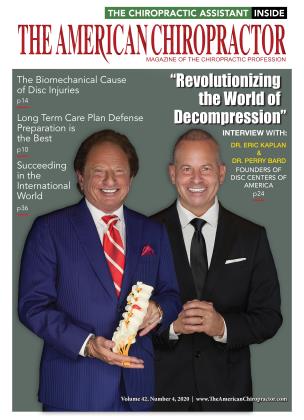The Liver Part II
LOOMIS
ORGAN
(Continued form March 2020)
By Howard F. Loomis, Jr., DC
Last month, we looked at how difficult it can be to recognize the early signs of liver involvement and focused on issues that we can use to educate our patients about the liver. This month, we discuss the liver’s direct involvement in the body’s “fight-or-flight” response. First, we’ll look at the embryology of the liver and its direct connections with the musculoskeletal system.
Embryological Development
Liver development occurs through a progressive series of reciprocal tissue interactions between the embryonic endoderm (visceral) and nearby mesoderm (structural). The first sign of the embryonic liver is the formation of the hepatic diverticulum, an out-pocket of thickened ventral foregut epithelium adjacent to the developing heart.
• The anterior portion gives rise to the liver and intrahepatic biliary tree.
• The posterior portion forms the gallbladder and extrahepatic bile ducts.
Hepatocytes are the principal cell type in the liver, accounting for 70% of the mass of the adult organ and, along with biliary epithelial cells, are derived from the embryonic endoderm. The liver contains the following special cells derived from the mesoderm, as well as the musculoskeletal system:
• Stromal cells are the connective tissue cells that support all organs.
• Stellate cells are fat-storing cells found in the space of Disse. The liver is responsible for forming 50% of the body’s lymph.
• Kupffer cells are specialized macrophages lining the walls of the sinusoids.
• All blood vessels.
Symptoms of Sympathetic Stimulation and Exhaustion
When the brain recognizes it lacks adequate glucose to meet its energy demands, it strongly stimulates both the sympathetic nervous system and the endocrine system to elevate available glucose levels.
The most significant liver responses to sympathetic stimulation are:
• Conversion and release of stored glycogen to elevate blood glucose.
• Conversion of stored cellular amino acids to glucose. Prolonged stress thus causes protein deficiency that goes undetected in blood tests.
• Reduction of bile production and its content of cholesterol, which now accumulates in the blood.
Arguably, the most important part of the “fight-orflight” response is for the liver to convert stored glycogen to glucose and put it into the bloodstream.
This, of course, is in response to epinephrine from the adrenal medulla.
Compensation Pathway
Obviously, if the stress is short-lived, then these functions have little effect. However, the body has great difficulty compensating for the long-term deleterious effects of stress and the continual path to metabolic syndrome and diabetes.
Once the supply of stored glycogen is in jeopardy of being exhausted, the cells send their stored amino acids to the liver for conversion to glucose. This is in response to the increased secretion of cortisol and thyroxine, which are amino acids intended to be used for growth and repair. Those processes are put on temporary hold until the acute stress has been resolved, which brings us to a key point in liver function. The liver is responsible for metabolizing dietary protein into individual amino acids. I presented the formation of those amino acids to the Annual Conference of the Food Enzyme Institute several years ago, but, for this discussion, we look for symptoms of protein deficiency.
The most obvious signs of protein deficiency are:
• Swelling - hands and feet
• Cold hands and feet
• Water gain
• Menstrual cramps
• Increased secretions in mouth/nose/eyes
• Patient does not tolerate exercise
Are those symptoms caused by inadequate protein ingestion, an inability to adequately digest protein, or an inability of the liver to metabolize protein?
Structural Relationships - Abdominal IMCStress Point Palpation
(IMC = Involuntary muscle contraction) The muscles of dorsolumbar flexion and rotation are involved with movement of the trunk and work in harmony with several other muscles to control the abdominal wall.
Nutrition
Last month’s article covered the concept of liver detoxification diets. We stated that many alternative health practitioners claim that limiting a patient’s diet to certain juices or foods will wash away toxins from the liver.
There is no scientific proof that these detox diets work, but that begs the question of what are the scientists measuring and basing that assumption on? What is known is that a healthy diet will give your liver the nutrients it needs to do its many jobs—provided digestion is adequate. So it would appear that while detoxification cannot be proven to be beneficial, perhaps it also does no harm.
Conclusion
This concludes our two-part presentation of how the liver responds to stress. Next month, we move on to the circulatory system, specifically the pericardium.
Howard F. Loomis, Jr., DC, has an extensive background in enzymes and enzyme supplements. He is the founder and president of the Food Enzyme Institute™. His extensive knowledge of physiology, biochemistry, and enzymology has made him a sought-after speaker and a prolific writer. In 2019, Dr. Loomis published his most recent book, "What Is Your Nutritional Deficiency?: Find It, Fix It, and Feel Better!" written with medical journalist Arnold Mann, [email protected] 800-662-2630. Food Enzyme Institute, 478 Commerce Dr. Suite 201, Madison, Wl 53719
 View Full Issue
View Full Issue






